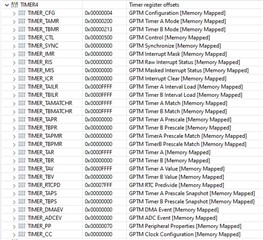Tool/software:
There is a pulse train on port D7 that I'm trying to count. Code:
SysCtlPeripheralEnable(SYSCTL_PERIPH_GPIOD);
SysCtlPeripheralEnable(SYSCTL_PERIPH_TIMER4);
GPIOPinTypeTimer(GPIO_PORTD_BASE, 0x80);
GPIOPinConfigure(GPIO_PD7_T4CCP1);
// Lots of code runs here so the peripherals are ready.
TimerDisable(TIMER4_BASE, TIMER_B);
TimerConfigure(TIMER4_BASE, TIMER_CFG_SPLIT_PAIR | TIMER_CFG_B_CAP_COUNT_UP | TIMER_CFG_B_ACT_NONE);
TimerControlEvent(TIMER4_BASE, TIMER_B, TIMER_EVENT_NEG_EDGE);
TimerEnable(TIMER4_BASE, TIMER_B);
TIMER4_TBV_R = 0;
// Every 1/4 second...
Count = TimerValueGet(TIMER4_BASE, TIMER_B);
TIMER4_TBV_R = 0;
But Count is always zero.
Thanks, Doug



